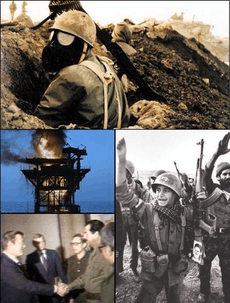United Nations Security Council Resolution 598
| UN Security Council Resolution 598 | |
|---|---|
|
Iran–Iraq War | |
| Date | 20 July 1987 |
| Meeting no. | 2,750 |
| Code | S/RES/598 (Document) |
| Subject |
Islamic Republic of Iran Iraq |
Voting summary |
15 voted for None voted against None abstained |
| Result | Adopted |
| Security Council composition | |
Permanent members | |
Non-permanent members | |
United Nations Security Council resolution 598 S/RES/0598 (1987), (UNSC resolution 598) [1] adopted unanimously on 20 July 1987, after recalling Resolution 582 and 588, called for an immediate ceasefire between Iran and Iraq and the repatriation of prisoners of war, and for both sides to withdraw to the international border. The resolution requested the Secretary-General to dispatch a team of observers to monitor the ceasefire while a permanent settlement was reached to end the conflict. It became effective on 8 August 1988, ending all combat operations between the two countries and the Iran–Iraq War.
Both Iran and Iraq had accepted Resolution 598 on 20 July 1988. However, Iraq decided to make a final push and attempted to invade Iran, once again, to permanently occupy Khuzestan and western Iran, as well as to reach its goals from the beginning of the war.[2] The Iraqi army attacked Khuzestan province, beginning with chemical and air strikes, and once again pushed towards Khorramshahr. However, Iran had anticipated the attack, and used its air force in conjunction with surface-to-air missiles to defeat the larger Iraqi air force.[2] The Iranian forces then took the offensive on 25 July and re-obtained 600 square kilometres (230 sq mi) of Iraqi territory.[2] See Operation Mersad.
Both sides eventually withdrew to the international border in the coming weeks, with Resolution 598 becoming effective on 8 August, ending all combat operations between the two countries.[3] UN peacekeepers belonging to the UNIIMOG mission took the field, remaining on the Iran–Iraq border until 1991. While the war was now over, Iraq spent the rest of August and early September clearing the Kurdish resistance. Using 60,000 troops along with helicopter gunships, chemical weapons (poison gas), and mass executions, Iraq hit 15 villages with poison gas, killing many rebels and civilians, and forced tens of thousands of Kurds to relocate to settlements.[4] Many Kurdish civilians immigrated to Iran. By 3 September 1988, the anti-Kurdish campaign ended and all resistance was crushed.[4] 400 Iraqi soldiers and 50,000 Kurdish civilians and soldiers had been killed.[4][5]
See also
- Iran–Iraq relations
- Iran–Iraq War
- List of United Nations Security Council Resolutions 501 to 600 (1982–1987)
- Resolutions 479, 514, 522, 540, 552, 582, 612, 616, 619 and 620
References
- ↑ http://www.cfr.org/iran/un-security-council-resolution-598-iran-iraq/p11200
- 1 2 3 Farrokh, Kaveh. Iran at War: 1500–1988. Oxford: Osprey Publishing. ISBN 9781780962214.
- ↑ Dodds, Joanna; Wilson, Ben (6 June 2009). "The Iran-Iraq War: Unattainable Objectives". Middle East Review of International Affairs. 13 (2).
- 1 2 3 "Phase Five: New Iranian Efforts at "Final Offensives", 1986–1887". The Lessons of Modern War – Volume II: Iran–Iraq War (PDF). Center for Strategic and International Studies.
- ↑ Wong, Edward (5 April 2006). "Hussein charged with genocide in 50,000 deaths". The New York Times.
External links
| Wikisource has original text related to this article: |
